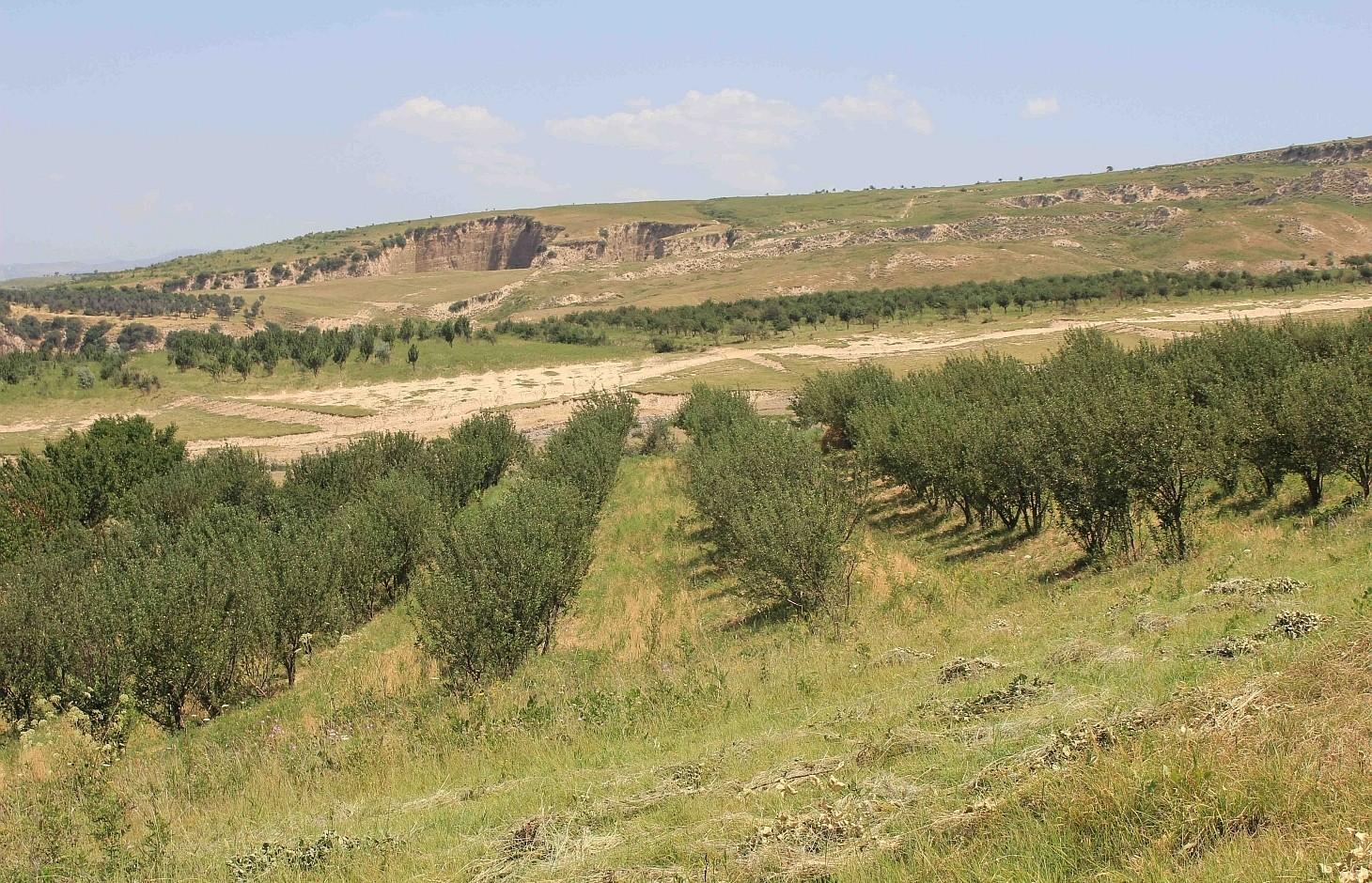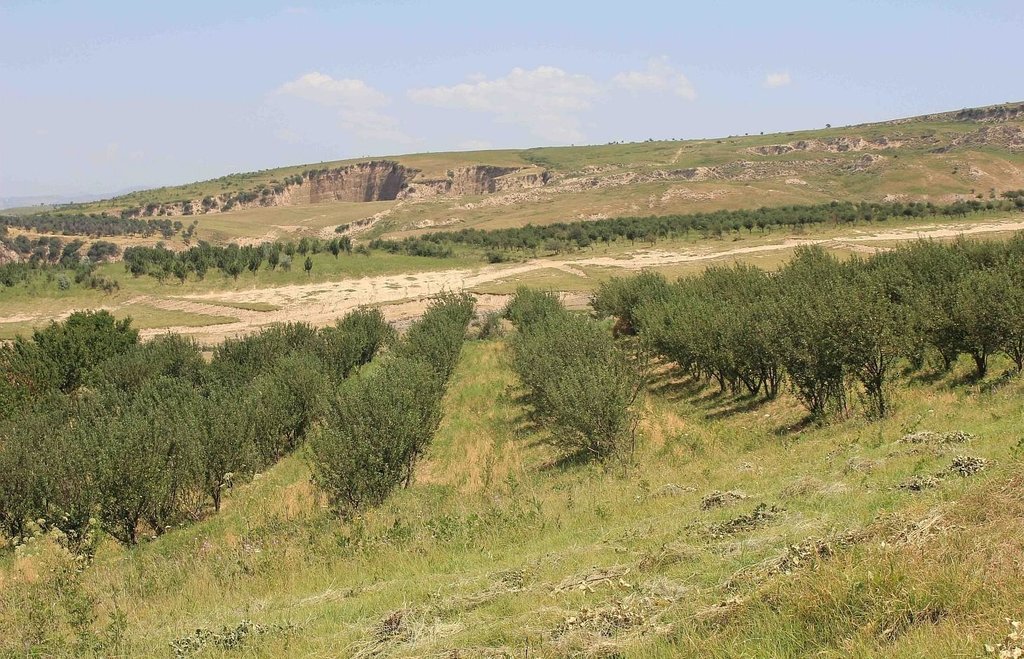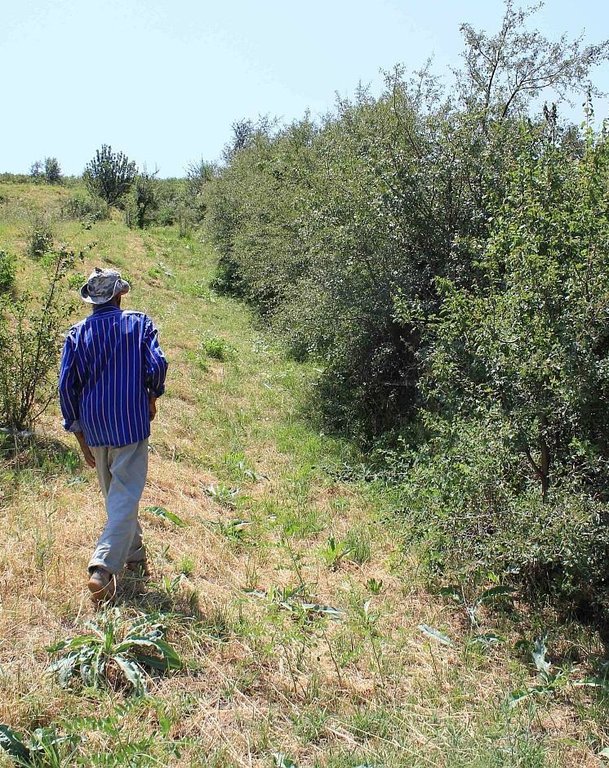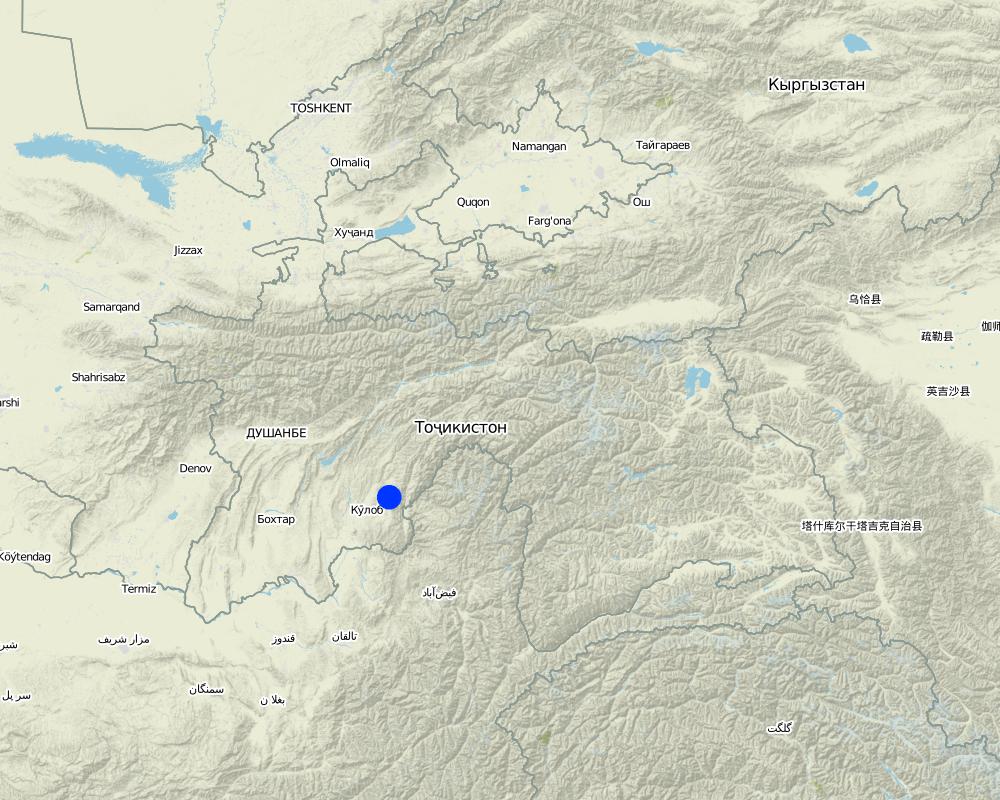Mixed fruit tree orchard with intercropping of Esparcet and annual crops in Muminabad District [Tadjikistan]
- Création :
- Mise à jour :
- Compilateur : Malgorzata Conder
- Rédacteur : –
- Examinateurs : Laura Ebneter, Alexandra Gavilano, Fabian Ottiger
Bog
technologies_1128 - Tadjikistan
- Résumé complet en PDF
- Résumé complet en PDF pour impression
- Résumé complet dans le navigateur
- Résumé complet (non formaté)
- Mixed fruit tree orchard with intercropping of Esparcet and annual crops in Muminabad District: 28 décembre 2016 (inactive)
- Mixed fruit tree orchard with intercropping of Esparcet and annual crops in Muminabad District: 31 mai 2017 (inactive)
- Mixed fruit tree orchard with intercropping of Esparcet and annual crops in Muminabad District: 2 juin 2017 (inactive)
- Mixed fruit tree orchard with intercropping of Esparcet and annual crops in Muminabad District: 4 août 2019 (public)
Voir les sections
Développer tout Réduire tout1. Informations générales
1.2 Coordonnées des personnes-ressources et des institutions impliquées dans l'évaluation et la documentation de la Technologie
Spécialiste GDT:
Nom du ou des institutions qui ont facilité la documentation/ l'évaluation de la Technologie (si pertinent)
NCCR North-South (NCCR North-South) - KirghizistanNom du ou des institutions qui ont facilité la documentation/ l'évaluation de la Technologie (si pertinent)
CARITAS (Switzerland) - Suisse1.3 Conditions relatives à l'utilisation par WOCAT des données documentées
Le compilateur et la(les) personne(s) ressource(s) acceptent les conditions relatives à l'utilisation par WOCAT des données documentées:
Oui
2. Description de la Technologie de GDT
2.1 Courte description de la Technologie
Définition de la Technologie:
Orchard based agroforestry established on the hill slopes of Muminabad
2.2 Description détaillée de la Technologie
Description:
Between 1993 and 94 an individual farmer initiated an orchard by planting a mix of fruit trees, such as apricots, walnuts, cherries, almonds and mostly apple trees in the rainfed hill zones of Muminabad District.
In the first couple of years 416 newly planted seedlings were watered manually: water was brought by trucks near to the plot and distributed to the seedlings with buckets. The orchard was established on the existing grazing land and therefore the seedlings had to be secured with a fence from livestock grazing nearby. First hard wire was used for fencing. Simultaneously, hawthorns (Dulona in Tajik) were planted along the fence in order to provide even stronger protection and establish a live fence for the future. Now, the fruit trees are fully-grown and fruits can be harvested every year. The farmer prunes trees annually, which is the key for fruit production. The farmer pointed out that in rainfed areas soils contain less nutrients and usually big trees do not produce high yield. Furthermore, pruned tree branches are used as firewood. The farmer also applies the pesticides B52 and B58, three times a year in the months of April, May and June. The total area of the plot is 1.03 hectares, whereof 0.60 hectares are orchard; Esparcet is covering roughly 0.30 hectares, 0.07 hectare is for haymaking and the rest of the 0.06 hectares is used for growing chickpea and wheat. There is also a road for machinery to pass and to turn around when plowing the land.
Purpose of the Technology: Shortly after the fall of the Soviet Union, the government officials distributed land to the villagers. The farmer always had a big interest to establish a small orchard and he obtained little more than a hectare of land. It is his project for retirement. He and his family worked hard throughout the establishment phase. They experimented by planting a variety of vegetables including melons and watermelons. The wild animals ate many of the vegetables and melons, what resulted in the farmer's idea of intercropping Esparcet.
Establishment / maintenance activities and inputs: According to the farmer, the first two years were very labor intensive and crucial to establish the orchard. He also had to face a challenge posed by the community, as overnight people from the nearby villages stole roughly 100 of his newly planted seedlings. This is one of the reasons why the farmer had to plant hawthorn in order to establish a live fence. In summary: The establishment phase included planting of young seedlings; manually watering for the first two years; plowing in between the tree rows by machinery; building a fence around the plot and planting/sowing hawthorns. Maintenance activities consist of the following activities: planting new seedlings; pruning of existing trees; grafting new sorts of trees, plowing by tractor in between the tree rows annually; chickpea and wheat cultivation; application of chemical pesticides three times a year. For cutting wheat, the farmer gets support from his son and friends. Every day, he goes to his orchard, which is located at a distance of more than 1.5km from his house. When this technology was documented he was about to build a small clay hut in his orchard.
It should be noted that the terrace structure was not implemented at once, but over the years tilling in between the tree rows along the contour lines formed terrace shaped rows.
The structure of terraces has been built over the years by tilling in between tree rows along the contour lines.
Natural / human environment: Muminabad is situated in the southwest of Tajikistan (Khatlon Province) and its hills are covered by loessial soil. Winter temperatures are low and the amount of precipitation is high. Summers are very hot and dry. The growing season lasts from March/ April to September/ October.
2.3 Photos de la Technologie
2.5 Pays/ région/ lieux où la Technologie a été appliquée et qui sont couverts par cette évaluation
Pays:
Tadjikistan
Région/ Etat/ Province:
Khatlon, Tajikistan
Autres spécifications du lieu:
Muminabad
Commentaires:
Total area covered by the SLM Technology is 0.01 km2.
1.03 ha in total, whereof 0.6 ha is orchard
Map
×2.6 Date de mise en œuvre de la Technologie
Si l'année précise est inconnue, indiquez la date approximative: :
- il y a entre 10-50 ans
2.7 Introduction de la Technologie
Spécifiez comment la Technologie a été introduite: :
- grâce à l'innovation d'exploitants des terres
3. Classification de la Technologie de GDT
3.2 Type(s) actuel(s) d'utilisation des terres, là où la Technologie est appliquée
Les divers types d'utilisation des terres au sein du même unité de terrain: :
Oui
Précisez l'utilisation mixte des terres (cultures/ pâturages/ arbres):
- Agroforesterie

Terres cultivées
- Plantations d’arbres ou de buissons
Plantations d'arbres et d'arbustes - Précisez les cultures:
- fruits à pépins (pommes, poires, coings, etc.)
- fruits à noyaux (pêche, abricot, cerise, prune)
Nombre de période de croissance par an: :
- 1
Précisez:
Longest growing period in days: 180Longest growing period from month to month: April-Sept/oct
Est-ce que les cultures intercalaires sont pratiquées?
Oui
Si oui, précisez quelles cultures sont produites en culture intercalaire:
wheat, chickpeas

Pâturages
Pâturage extensif:
- Pastoralisme de type semi-nomade

Forêts/ bois
Commentaires:
Major land use problems (compiler’s opinion): Soil erosion by water, heavy rainfalls, absence of vegetative cover on the hill slopes.
Major land use problems (land users’ perception): Soil erosion by water, extensive grazing, gully erosion.
3.4 Approvisionnement en eau
Approvisionnement en eau des terres sur lesquelles est appliquée la Technologie:
- mixte: pluvial-irrigué
3.6 Mesures de GDT constituant la Technologie

pratiques végétales
- V1: Couverture d’arbres et d’arbustes

modes de gestion
- M2: Changement du niveau de gestion / d'intensification
Commentaires:
Type of vegetative measures: aligned: -contour
3.7 Principaux types de dégradation des terres traités par la Technologie

érosion hydrique des sols
- Wt: perte de la couche superficielle des sols (couche arable)/ érosion de surface
- Wg: ravinement/ érosion en ravines
Commentaires:
Main causes of degradation: soil management (Extensive grazing led to a reduction of soil cover, which is the major source of erosion), deforestation / removal of natural vegetation (incl. forest fires) (Removal of trees left the soil unprotected against precipitation and extreme weather events), over-exploitation of vegetation for domestic use (Trees were cut as firewood for fuel consumption), overgrazing, land tenure (Land abandonment after Soviet collapse), governance / institutional (Lacking istitutional support)
Secondary causes of degradation: Heavy / extreme rainfall (intensity/amounts) (More extreme rainfall events), floods (As a result of extreme events there are more floods in the region)
3.8 Prévention, réduction de la dégradation ou réhabilitation des terres dégradées
Spécifiez l'objectif de la Technologie au regard de la dégradation des terres:
- prévenir la dégradation des terres
- réduire la dégradation des terres
Commentaires:
Main goals: prevention of land degradation, mitigation / reduction of land degradation
Secondary goals: rehabilitation / reclamation of denuded land
4. Spécifications techniques, activités, intrants et coûts de mise en œuvre
4.1 Dessin technique de la Technologie
Spécifications techniques (associées au dessin technique):
The fenced plot is mainly used for the orchard intercropped with chickpea, flax and wheat. Esparcet and grass for haymaking covers only a small part of the plot. The part on the left handside is also used to turn the tractor when ploughing, which is why this part is affected by soil erosion and rills. The whole property is fenced by hawthorns (dulona). The orchard has a terrace-like structure due to annual plowing by tractor.
Location: Sarmaydon 2. Muminabad
Technical knowledge required for field staff / advisors: moderate
Technical knowledge required for land users: moderate
Main technical functions: control of raindrop splash, control of dispersed runoff: retain / trap, control of dispersed runoff: impede / retard, improvement of ground cover, water harvesting / increase water supply, increase of biomass (quantity)
Secondary technical functions: improvement of surface structure (crusting, sealing), improvement of topsoil structure (compaction), increase in organic matter, increase / maintain water stored in soil, reduction in wind speed
Aligned: -contour
Number of plants per (ha): 416
Vertical interval between rows / strips / blocks (m): 3
Vertical interval within rows / strips / blocks (m): 3.5
Fruit trees / shrubs species: apple, apricot, pear, cherry
Other species: intercropped with chickpea and wheat
Auteur:
Q. Shokirov
Date:
12-07-2012
4.2 Informations générales sur le calcul des intrants et des coûts
autre/ monnaie nationale (précisez):
Somoni
Indiquez le taux de change des USD en devise locale, le cas échéant (p.ex. 1 USD = 79.9 réal brésilien): 1 USD = :
4,83
Indiquez le coût salarial moyen de la main d'œuvre par jour:
12.40
4.3 Activités de mise en place/ d'établissement
| Activité | Calendrier des activités (saisonnier) | |
|---|---|---|
| 1. | Digging a deep barrier for protection around the plot with a bulldozer, 1 day | once (1993) |
| 2. | Plowing in between the rows by tractor, labor, petrol and rent for one day | once (1993) |
| 3. | Planting fruit trees, 3 days by 3 persons (3-5 Somoni per seedling, 3 Som/ seedling planting) | once (1993) |
| 4. | Watering young seedlings for the first couple of years by truck (60 TJS per truck) | one day a week/ 50 times a year |
| 5. | Construction of fence with hard wire and haw thorn (approx. 320m) | once |
| 6. | Buying and replanting of 100 stolen fruit seedlings | once |
4.4 Coûts et intrants nécessaires à la mise en place
| Spécifiez les intrants | Unité | Quantité | Coûts par unité | Coût total par intrant | % des coût supporté par les exploitants des terres | |
|---|---|---|---|---|---|---|
| Main d'œuvre | Labour | ha | 1,0 | 4629,333 | 4629,33 | 100,0 |
| Equipements | Machine use | ha | 1,0 | 227,833 | 227,83 | 100,0 |
| Equipements | Petrol | l | 20,0 | 1,14 | 22,8 | 100,0 |
| Matériel végétal | Seedlings | Pieces | 516,0 | 0,621 | 320,44 | 100,0 |
| Matériaux de construction | Hard wire and pillars | m | 320,0 | 1,4556 | 465,79 | 100,0 |
| Coût total de mise en place de la Technologie | 5666,19 | |||||
| Coût total de mise en place de la Technologie en dollars américains (USD) | 1173,12 | |||||
Commentaires:
Duration of establishment phase: 24 month(s)
4.5 Activités d'entretien/ récurrentes
| Activité | Calendrier/ fréquence | |
|---|---|---|
| 1. | Tractor ploughing, labor, petrol and rent, 1-2 hours, 2 persons | spring, once a year |
| 2. | Soil loosening around trees, 5-6 days, 3-4 persons | spring, once a year |
| 3. | Pruning of the approx. 400 fruit trees (3 TJS per tree) | every year |
| 4. | Bringing water from village and watering (40 liters a day,20l on each donkey, 3 h for walking and watering) | every day |
| 5. | Applying pesticides, 1 person, 7 days (5 hours per day) | Three times a year: April, May, June |
| 6. | Sowing wheat and chickpea (1 person, 2 hours) | spring, once a year |
| 7. | Cutting wheat and chickpea (2 persons, 4 hours) | autumn, once |
| 8. | Harvesting fruit trees (3.6 TJS per fruit tree) | autumn, once a year |
4.6 Coûts et intrants nécessaires aux activités d'entretien/ récurrentes (par an)
| Spécifiez les intrants | Unité | Quantité | Coûts par unité | Coût total par intrant | % des coût supporté par les exploitants des terres | |
|---|---|---|---|---|---|---|
| Main d'œuvre | Labour | ha | 1,0 | 4493,5 | 4493,5 | 100,0 |
| Equipements | Machine use | ha | 1,0 | 10,3 | 10,3 | 100,0 |
| Equipements | Petrol | l | 20,0 | 1,14 | 22,8 | 100,0 |
| Matériel végétal | Pesticides | kg | 0,25 | 186,0 | 46,5 | 100,0 |
| Matériel végétal | Seeds | pc | 1,0 | 3,7 | 3,7 | 100,0 |
| Coût total d'entretien de la Technologie | 4576,8 | |||||
| Coût total d'entretien de la Technologie en dollars américains (USD) | 947,58 | |||||
4.7 Facteurs les plus importants affectant les coûts
Décrivez les facteurs les plus importants affectant les coûts :
The technology was established during the Soviet Union and most of the expenses were calculated on the price basis of that time. If technology is priced by current prices, the total sum would be very high and no farmer would be able to afford. Thus, current prices were not identified. Nowadays, machinery cost, buying hard wire for fencing and buying seedlings would be the most costly factors.
5. Environnement naturel et humain
5.1 Climat
Précipitations annuelles
- < 250 mm
- 251-500 mm
- 501-750 mm
- 751-1000 mm
- 1001-1500 mm
- 1501-2000 mm
- 2001-3000 mm
- 3001-4000 mm
- > 4000 mm
Zone agro-climatique
- subhumide
Thermal climate class: temperate
5.2 Topographie
Pentes moyennes:
- plat (0-2 %)
- faible (3-5%)
- modéré (6-10%)
- onduleux (11-15%)
- vallonné (16-30%)
- raide (31-60%)
- très raide (>60%)
Reliefs:
- plateaux/ plaines
- crêtes
- flancs/ pentes de montagne
- flancs/ pentes de colline
- piémonts/ glacis (bas de pente)
- fonds de vallée/bas-fonds
Zones altitudinales:
- 0-100 m
- 101-500 m
- 501-1000 m
- 1001-1500 m
- 1501-2000 m
- 2001-2500 m
- 2501-3000 m
- 3001-4000 m
- > 4000 m
5.3 Sols
Profondeur moyenne du sol:
- très superficiel (0-20 cm)
- superficiel (21-50 cm)
- modérément profond (51-80 cm)
- profond (81-120 cm)
- très profond (>120 cm)
Texture du sol (de la couche arable):
- grossier/ léger (sablonneux)
Matière organique de la couche arable:
- moyen (1-3%)
5.4 Disponibilité et qualité de l'eau
Profondeur estimée de l’eau dans le sol:
> 50 m
Disponibilité de l’eau de surface:
faible/ absente
Qualité de l’eau (non traitée):
eau inutilisable
5.5 Biodiversité
Diversité des espèces:
- moyenne
5.6 Caractéristiques des exploitants des terres appliquant la Technologie
Orientation du système de production:
- subsistance (auto-approvisionnement)
Revenus hors exploitation:
- 10-50% de tous les revenus
Niveau relatif de richesse:
- moyen
Individus ou groupes:
- individu/ ménage
Niveau de mécanisation:
- travail manuel
- mécanisé/ motorisé
Genre:
- femmes
- hommes
Indiquez toute autre caractéristique pertinente des exploitants des terres:
Population density: 100-200 persons/km2
Annual population growth: 1% - 2%
40% of the land users are average wealthy.
5.7 Superficie moyenne des terres utilisées par les exploitants des terres appliquant la Technologie
- < 0,5 ha
- 0,5-1 ha
- 1-2 ha
- 2-5 ha
- 5-15 ha
- 15-50 ha
- 50-100 ha
- 100-500 ha
- 500-1 000 ha
- 1 000-10 000 ha
- > 10 000 ha
Cette superficie est-elle considérée comme de petite, moyenne ou grande dimension (en se référant au contexte local)?
- petite dimension
5.8 Propriété foncière, droits d’utilisation des terres et de l'eau
Propriété foncière:
- état
Droits d’utilisation des terres:
- loué
Commentaires:
Land ownership is based on the land user certificate conferred by the government.
5.9 Accès aux services et aux infrastructures
santé:
- pauvre
- modéré
- bonne
éducation:
- pauvre
- modéré
- bonne
assistance technique:
- pauvre
- modéré
- bonne
emploi (par ex. hors exploitation):
- pauvre
- modéré
- bonne
marchés:
- pauvre
- modéré
- bonne
énergie:
- pauvre
- modéré
- bonne
routes et transports:
- pauvre
- modéré
- bonne
eau potable et assainissement:
- pauvre
- modéré
- bonne
services financiers:
- pauvre
- modéré
- bonne
6. Impacts et conclusions
6.1 Impacts sur site que la Technologie a montrés
Impacts socio-économiques
Production
production agricole
production fourragère
qualité des fourrages
production de bois
surface de production
Disponibilité et qualité de l'eau
demande pour l'eau d'irrigation
Revenus et coûts
dépenses pour les intrants agricoles
revenus agricoles
diversité des sources de revenus
charge de travail
Impacts socioculturels
sécurité alimentaire/ autosuffisance
possibilités de loisirs
apaisement des conflits
Impacts écologiques
Cycle de l'eau/ ruissellement
ruissellement de surface
évaporation
Sols
humidité du sol
couverture du sol
perte en sol
encroûtement/ battance du sol
compaction du sol
matière organique du sol/ au dessous du sol C
Biodiversité: végétale, animale
biomasse/ au dessus du sol C
diversité des habitats
6.2 Impacts hors site que la Technologie a montrés
inondations en aval
capacité tampon/de filtration
6.3 Exposition et sensibilité de la Technologie aux changements progressifs et aux évènements extrêmes/catastrophes liés au climat (telles que perçues par les exploitants des terres)
Changements climatiques progressifs
Changements climatiques progressifs
| Saison | Augmentation ou diminution | Comment la Technologie fait-elle face à cela? | |
|---|---|---|---|
| températures annuelles | augmente | pas bien |
Extrêmes climatiques (catastrophes)
Catastrophes météorologiques
| Comment la Technologie fait-elle face à cela? | |
|---|---|
| pluie torrentielle locale | bien |
| tempête de vent locale | bien |
Catastrophes climatiques
| Comment la Technologie fait-elle face à cela? | |
|---|---|
| sécheresse | pas bien |
Catastrophes hydrologiques
| Comment la Technologie fait-elle face à cela? | |
|---|---|
| inondation générale (rivière) | pas bien |
6.4 Analyse coûts-bénéfices
Quels sont les bénéfices comparativement aux coûts de mise en place (du point de vue des exploitants des terres)?
Rentabilité à court terme:
neutre / équilibrée
Rentabilité à long terme:
très positive
Quels sont les bénéfices comparativement aux coûts d'entretien récurrents (du point de vue des exploitants des terres)?
Rentabilité à court terme:
neutre / équilibrée
Rentabilité à long terme:
très positive
Commentaires:
After 6 years income is very comparable to the establishment cost
6.5 Adoption de la Technologie
Commentaires:
98% of land user families have adopted the Technology with external material support
2% of land user families have adopted the Technology without any external material support
5 land user families have adopted the Technology without any external material support
There is a little trend towards spontaneous adoption of the Technology
Comments on adoption trend: Cost of the technology is very expensive, which discourages farmers to implement orchards based agroforestry.
6.7 Points forts/ avantages/ possibilités de la Technologie
| Points forts/ avantages/ possibilités du point de vue de l'exploitant des terres |
|---|
|
Grafting trees especially apple and pear trees on native hawthorns is an affordable and sustainable way of creating orchards in semi-arid areas with rainfed agriculture. Hawthorn is a plant adjusted to dry areas with strong and deep roots, which endures the hot summer months. How can they be sustained / enhanced? Tree nursery workshops and educational programmes about local species through seed associations |
|
Intercropping wheat, chickpea, flax and Esparcet in between the tree rows gives an extra economic incentive and also improves land productivity. How can they be sustained / enhanced? Knowledge raising, inspection of those good practices by other farmers |
| Haymaking with natural grass and Esparcet provide the farmer with an opportunity to produce hay for the winter months for his livestock, so that he does not need to purchase it from the market at high costs. |
| The farmer practices pruning on a regular basis to keep the trees in good shape for better fruit production, but also to have sufficient fire wood for the winter months. |
| Points forts/ avantages/ possibilités du point de vue du compilateur ou d'une autre personne ressource clé |
|---|
|
Compared to other plots with orchards there is almost no soil erosion which is mainly due to good land management practices, e.g. the slow building up of terraces. How can they be sustained / enhanced? Sustain the practice of contour ploughing |
6.8 Faiblesses/ inconvénients/ risques de la Technologie et moyens de les surmonter
| Faiblesses/ inconvénients/ risques du point de vue de l’exploitant des terres | Comment peuvent-ils être surmontés? |
|---|---|
| It is expensive to establish such orchards nowadays, because of the high cost for purchasing seedlings and hiring other machinery. | See comment below |
| Growing new seedlings and grafting trees is a cheaper way of establishing a new orchard, but it is not commonly practiced among the farmers in the region. | There should be a tree nursery workshop in order to raise awareness among the young generation of farmers. |
| Faiblesses/ inconvénients/ risques du point de vue du compilateur ou d'une autre personne ressource clé | Comment peuvent-ils être surmontés? |
|---|---|
| Since the orchard is located in a rainfed area, hot summer months make the technology vulnerable to drought. To some extent the technology is tolerant to dryer summers, but maybe not for prolonged droughts (e.g. two successive drought). |
The farmer has suggested that grafting fruit trees on native hawthorn (dulona) trees has potential for farmers when establishing orchards in rainfed areas. In extreme events (extremely dry years), the farmer brings water for supplementary irrigation from his house by donkey. |
7. Références et liens
7.1 Méthodes/ sources d'information
Liens et modules
Développer tout Réduire toutLiens
Aucun lien
Modules
Aucun module trouvé





